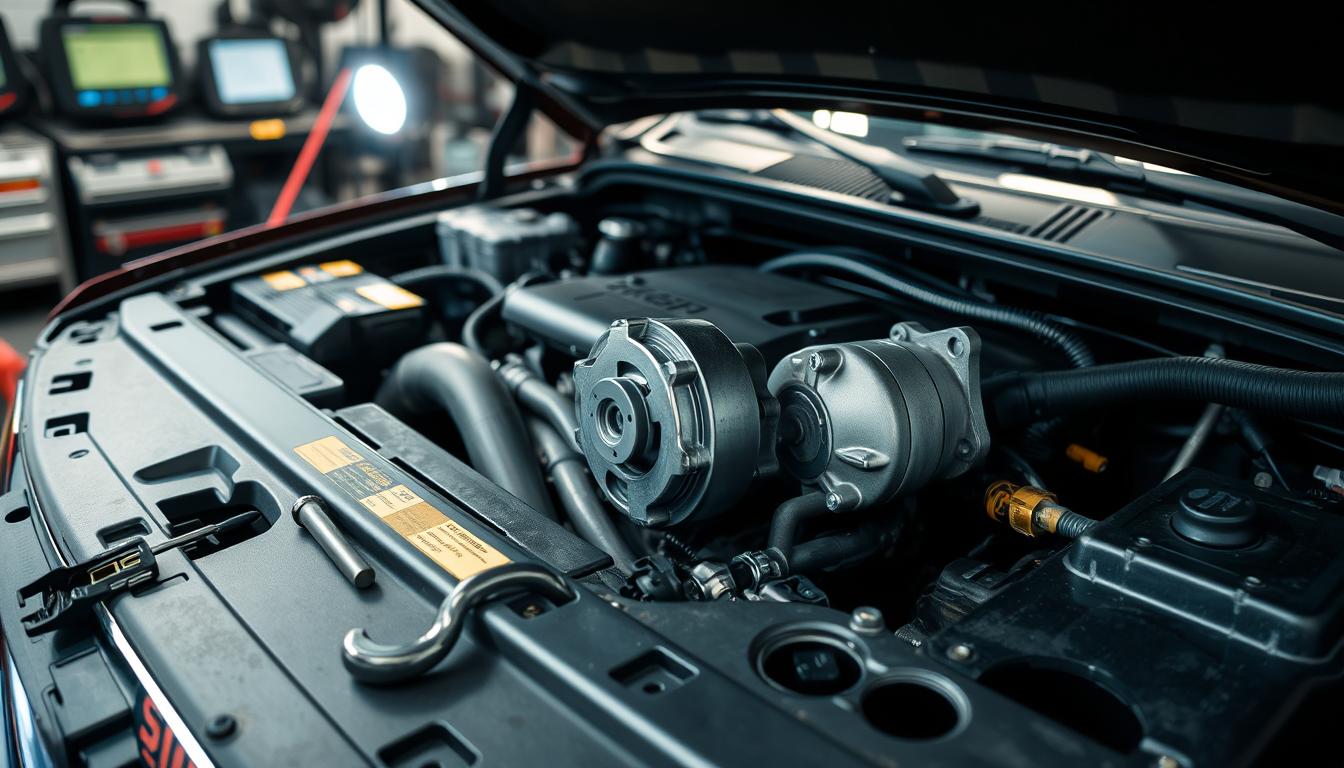Are you having trouble with your Nissan Frontier starter? Finding solutions can seem hard, but it’s doable with the right help. This guide will help you diagnose and fix starter issues. You’ll learn about the starting system and how to replace parts step by step.
With 23,683 Nissan Frontiers listed on CarGurus, starting at $2,799, many owners face starter problems. We’ll show you how to fix issues like a bad starter motor, poor connections, or blown fuses. You’ll learn how to make your Nissan Frontier run smoothly again.
Key Takeaways
- Understanding the starting system is crucial to diagnosing and fixing Nissan Frontier starter problems
- Troubleshooting Nissan Frontier starter issues requires a step-by-step approach
- A fully charged car battery should read about 12.6 VDC
- Testing for DC voltage between a ground point and the large wire on the starter can diagnose a blown fuse
- Diagnosing the starting circuit requires following a wiring diagram and ensuring there is 12V at each point along the circuit
- Regular maintenance can help prevent Nissan Frontier starter problems and ensure a longer lifespan for your vehicle
- With the right tools and knowledge, you can fix your Nissan Frontier starter problems and get back on the road quickly and efficiently
Understanding Your Nissan Frontier’s Starting System
The starting system of your Nissan Frontier is key for it to run well. It has several important parts that work together. They help start the engine and get your truck moving.
Key Components of the Starting System
- Battery: Supplies the necessary electrical power.
- Starter Motor: Engages the engine to start the vehicle.
- Solenoid: Acts as a switch to activate the starter motor.
How the Starter Motor Works
The starter motor turns the engine over when you start it. When you turn the key, the solenoid gets a signal. This lets current flow from the battery to the starter motor. The engine then spins, starting the combustion process.
Common Failure Points
Knowing common Nissan Frontier starter problems helps diagnose issues early. A common problem is the starter relay in the IPDM fuse box failing. This stops the starter motor from getting power. Also, wear and tear on the solenoid or connections can cause starter failures.
| Common Starter Problem | Symptoms |
|---|---|
| Starter Relay Failure | No response when turning the key |
| Worn Solenoid | Clicking sound but engine doesn’t start |
| Faulty Starter Motor | Engine turns slowly or not at all |
Essential Safety Precautions Before Starting
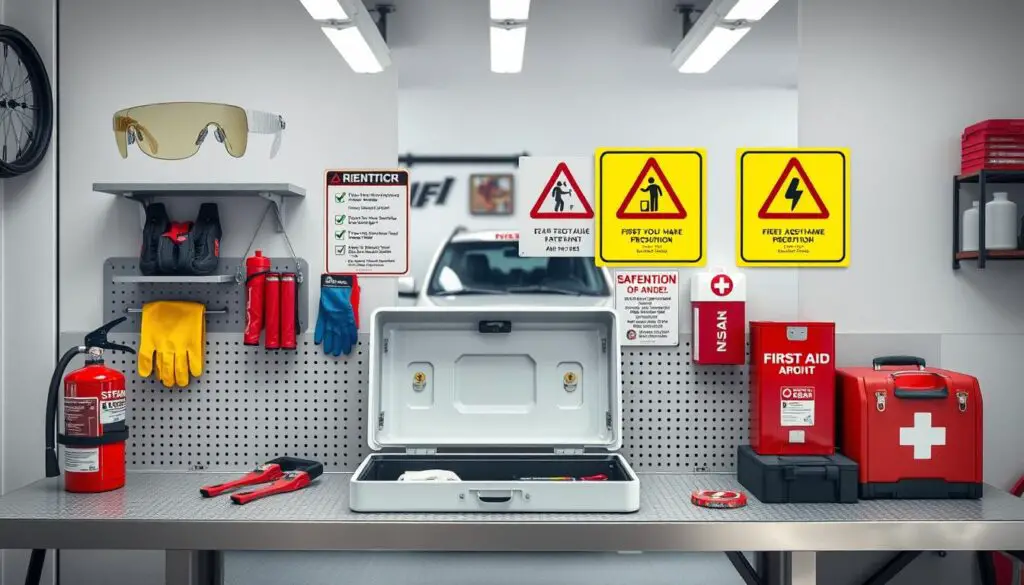
Before starting your DIY Nissan Frontier starter repair, safety comes first. Make sure to disconnect the battery to avoid any electrical problems.
Work in a well-ventilated area to stay safe from harmful fumes. Good ventilation keeps your workspace safe while you work on your car.
Wearing the right safety gear is key. Always wear protective gloves and safety glasses to protect yourself from harm.
- Protective gloves
- Safety glasses
- Closed-toe shoes
- Appropriate clothing
Also, have a fire extinguisher ready when fixing your Nissan Frontier starter. It’s a lifesaver in case of electrical sparks.
By taking these safety steps, your DIY repair will be safe and successful. These precautions make the repair process smoother and safer.
Required Tools and Materials for Starter Diagnosis
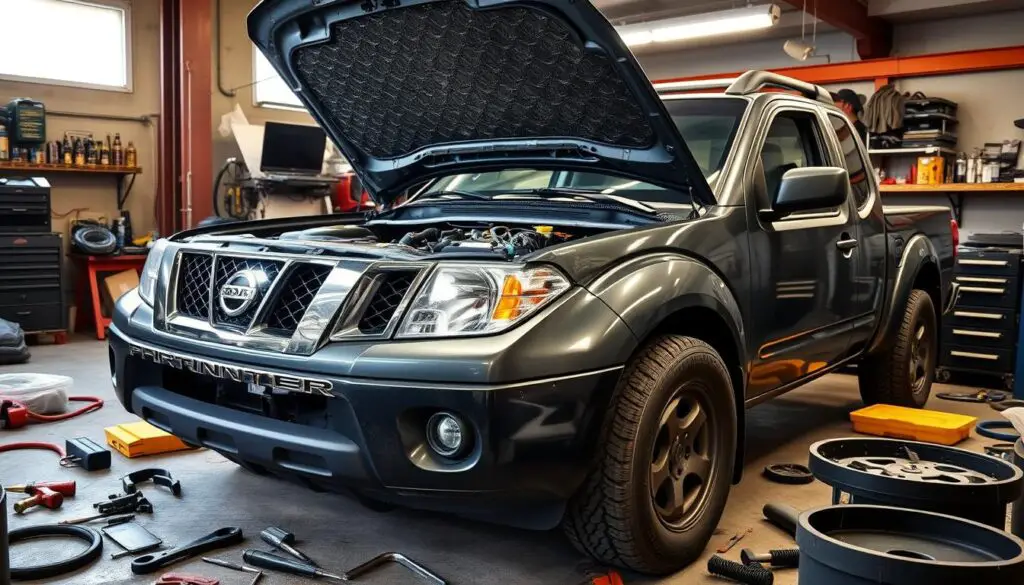
Starting a DIY Nissan Frontier starter repair needs the right tools and materials. Being ready makes the repair smooth and quick.
Basic Hand Tools Needed
- 1/4″ drive ratchet with 10, 12, & 14 MM sockets
- 10 MM box wrench
- 1/2 drive ratchet
- 14 MM Stubby combo wrench
- 3/8″ drive ratchet with extensions
Diagnostic Equipment Requirements
Getting the starter right is key for a good Nissan Frontier starter replacement. You’ll need:
- OBD-II scanner
- Multimeter for electrical tests
- Battery tester to check voltage
Safety Equipment Checklist
Always keep safety first during repairs. Make sure you have:
- Safety gloves to protect your hands
- Goggles to keep your eyes safe from debris
- Protective clothing to avoid scratches and burns
Having these tools and materials ready makes the DIY Nissan Frontier starter repair easier. It also makes the job safer and more efficient.
| Tool/Material | Purpose |
|---|---|
| 1/4″ Drive Ratchet | Used for loosening and tightening bolts of various sizes |
| 10 MM Box Wrench | Essential for accessing tight spaces around the starter |
| OBD-II Scanner | Diagnoses electrical issues within the starting system |
| Multimeter | Measures electrical voltage and continuity |
| Safety Gloves | Protects hands from sharp objects and electrical hazards |
| Goggles | Shields eyes from debris and sparks during repair |
Common Nissan Frontier Starter Problems and Symptoms
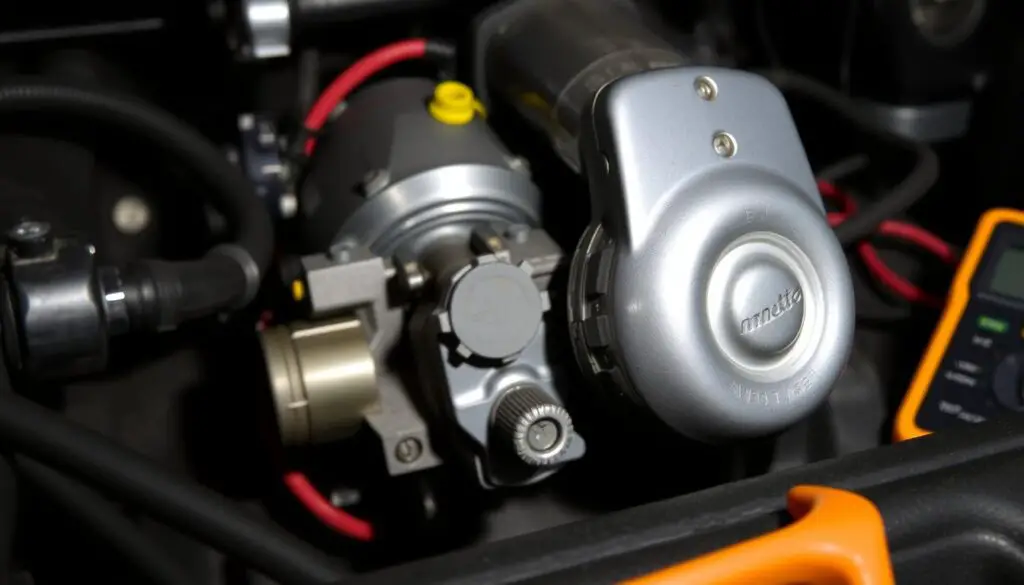
Having trouble with your Nissan Frontier’s starter can be really frustrating. Spotting the signs early can help save you time and money.
- Nissan Frontier starter clicking noise: A single click when you turn the key usually means starter motor issues.
- Slow cranking: The engine takes longer to turn over, which could mean starter or battery problems.
- Engine not turning over: If it won’t start at all, it’s a big sign of a serious starter problem.
If you hear a clicking sound, it usually means the starter solenoid is working but the starter motor isn’t. Slow cranking might be because of a weak battery or worn starter parts. If the engine won’t turn over, it could be a bad starter or electrical system issues.
| Symptom | Possible Cause | Suggested Action |
|---|---|---|
| Nissan Frontier starter clicking noise | Faulty starter solenoid | Inspect and replace the starter solenoid if necessary |
| Slow cranking | Weak battery or worn starter motor | Test the battery and starter motor; replace if needed |
| Engine not turning over | Severe starter failure or electrical issues | Perform a comprehensive electrical diagnosis and replace the starter |
Diagnosing Your Starter Issue

When your Nissan Frontier starter not engaging, it’s key to follow a step-by-step approach. This helps find the exact problem. It also saves time and avoids costly repairs.
Battery Testing Procedure
First, check the battery’s health. Use a multimeter to see if it has around 12.6 volts when the engine is off. If it’s lower, you might need to recharge or replace it.
Starter Circuit Testing
Then, look at the starter circuit for any issues. Find the starter relay in the IPDM fuse box and test it. Make sure it works right. Also, check all electrical connections for corrosion or looseness, which can stop the starter from working.
Solenoid Check Process
Last, check the solenoid. Listen for a click when trying to start the car. This means the solenoid is working. If you don’t hear anything, it might be broken and need to be replaced.
Accessing the Starter in Your Nissan Frontier
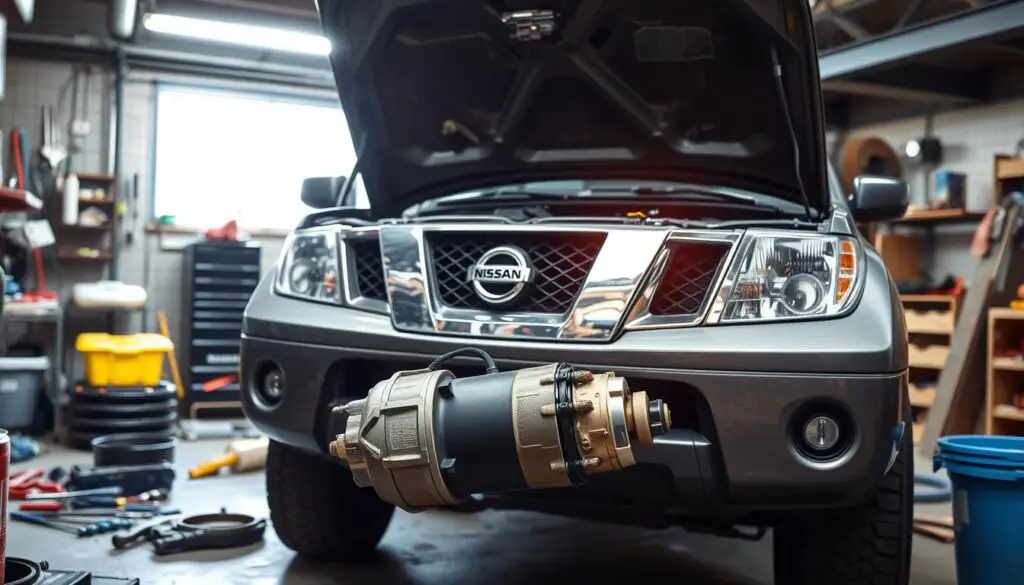
To start how to fix Nissan Frontier starter, first, you need to get to the starter motor. Begin by safely lifting your vehicle and securing it on jack stands.
Next, remove the under pan to clear the area under the engine. This gives you the room needed to reach the starter. Then, carefully remove the power steering fluid tubing from the steering rack. Make sure you have a container ready to catch any leftover fluid.
- Lift and secure the vehicle on jack stands.
- Unscrew and remove the under pan.
- Disconnect the power steering fluid tubing from the steering rack.
After removing these parts, you’ll have easy access to the starter. This access is key for both finding and fixing starter issues and for a Nissan Frontier starter replacement. Always check that battery connections and cables are tight. Loose connections can seem like starter problems.
By following these steps, you’re ready for a successful starter replacement. This ensures your Nissan Frontier stays reliable and efficient.
Step-by-Step Starter Removal Process
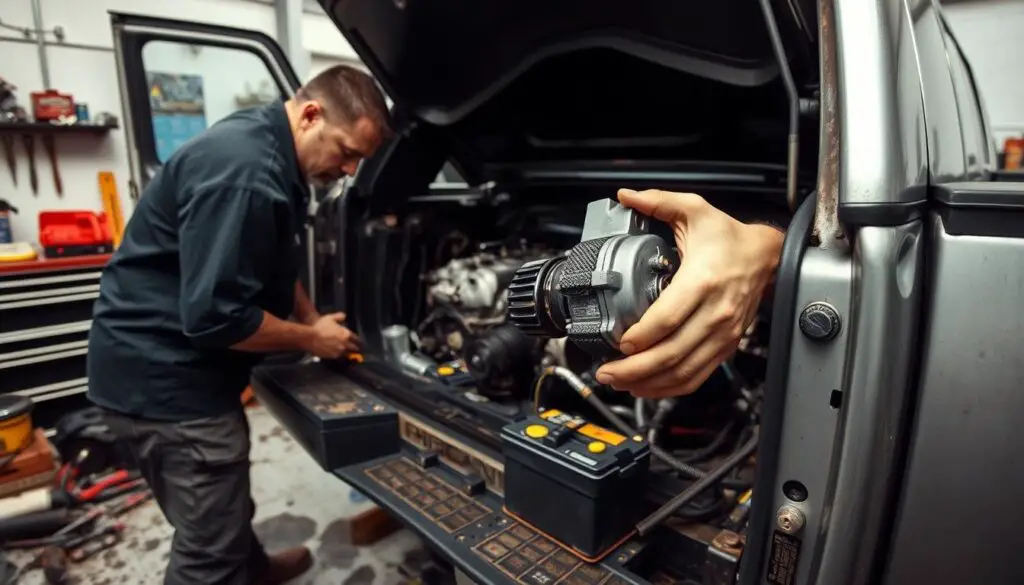
Removing the starter from your Nissan Frontier is easy with the right tools and steps. Follow this guide for a smooth DIY Nissan Frontier starter repair.
Disconnecting the Battery
Start by disconnecting the battery for safety.
- Use a 12 MM socket on a 1/4″ drive ratchet to detach the battery connection to the solenoid.
- Remove the negative terminal first to prevent any electrical shorts.
Removing Electrical Connections
Then, handle the electrical components connected to the starter.
- Locate the power steering fluid tubing attached to the steering rack.
- Use a 10 MM box wrench to remove the two bolts securing the tubing.
Unbolting the Starter
Lastly, unbolt the starter from the engine.
- Loosen the upper starter bolt using a stubby 14 MM combo wrench with a 1/2″ drive ratchet.
- Maneuver the 3/8″ drive extensions to access and loosen the lower starter bolt.
- Carefully remove the starter once all bolts are free.
Starter Replacement Options and Costs
When you think about replacing a Nissan Frontier starter, you have to decide between OEM and aftermarket parts. Each choice has its own pros and cons, affecting how well you can fix the starter.
OEM vs Aftermarket Parts
OEM starters are made by Nissan, so they fit perfectly and work well. They usually come with a warranty, giving you confidence. But, aftermarket starters are cheaper and made by other companies. They might not last as long or work as well.
Labor Costs Breakdown
The cost to replace a starter in a Nissan Frontier depends on the mechanic’s rate and the job’s complexity. Labor usually costs between $150 to $300. Always ask for a detailed estimate to know the total cost.
| Part Type | Cost | Warranty |
|---|---|---|
| OEM Starter | $250 – $400 | 1 Year |
| Aftermarket Starter | $100 – $250 | 6 Months to 1 Year |
| Labor | $150 – $300 | Depends on Service Provider |
Installing the New Starter
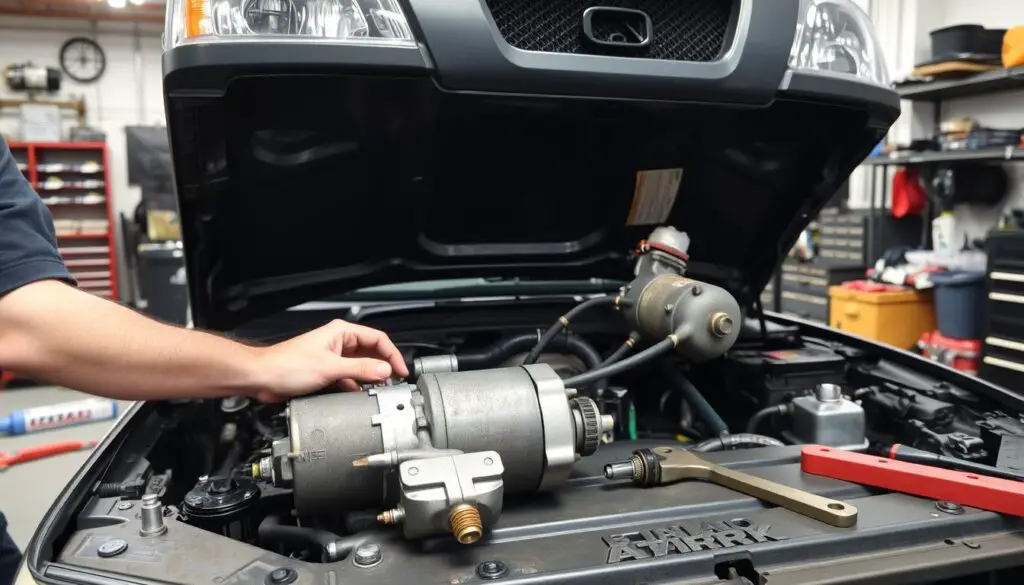
Start your DIY Nissan Frontier starter repair by lining up the new starter with its spot. Make sure all electrical connections are right to avoid any problems.
- Reattach Electrical Connections: Connect the positive cable to the starter’s terminal securely. Double-check that all wires are firmly attached.
- Secure the Starter: Use the right bolts to attach the starter to the engine block or transmission case. Tighten them as the manufacturer says.
- Reconnect the Battery: Carefully put back the battery terminals, making sure there’s no corrosion. A good connection is key for the starter’s work.
- Refill Power Steering Fluid: Before starting the engine, fill up the power steering fluid to the right level. This prevents steering problems.
After you install, check all connections to make sure they’re tight and leak-free. Proper alignment and secure fastening are key for your starter’s long life.
By following each step carefully, you can do a successful DIY Nissan Frontier starter repair. This reduces the chance of future starter issues.
| Step | Action |
|---|---|
| 1 | Reattach Electrical Connections |
| 2 | Secure the Starter |
| 3 | Reconnect the Battery |
| 4 | Refill Power Steering Fluid |
Testing the New Installation
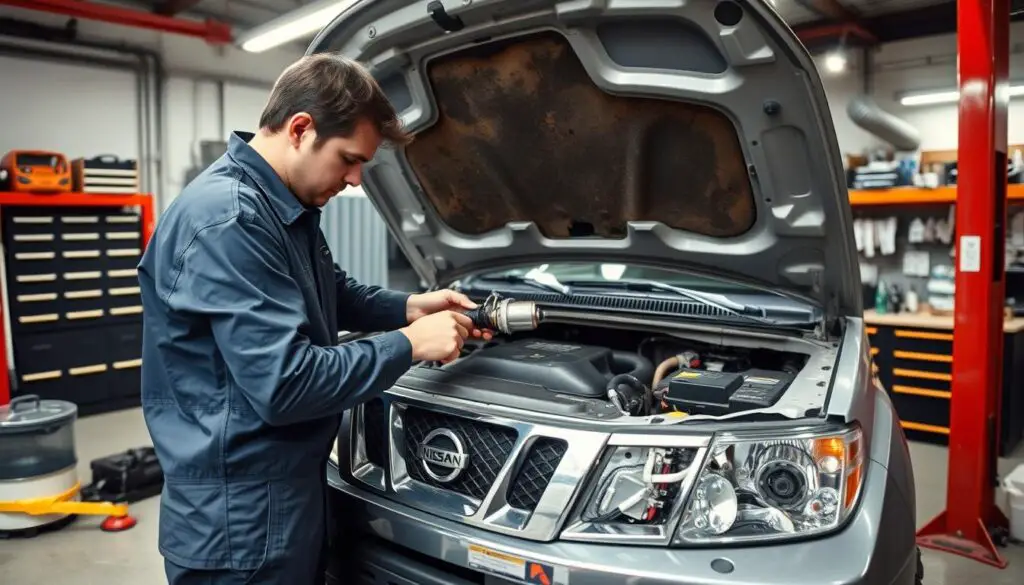
After fixing the Nissan Frontier starter, it’s important to test the new starter. This ensures it works right and the car is ready to go. Testing is key to fixing the starter problem and getting the car running well.
Initial Testing Procedures
First, reconnect the battery and turn the key to “start”. Listen for a smooth start from the starter motor. It should click without any grinding sounds.
Use a multimeter to check for at least 10.5 volts at the starter motor terminals. This shows the starter is getting enough power. A Battery Load Tester can also find any battery issues that might affect the starter.
Break-in Recommendations
Don’t crank the engine too much in the first few days. Start with short, gentle starts to help the starter motor settle. Also, check for oil leaks around the starter, as oil can damage it over time.
By following these steps, your Nissan Frontier starter will run smoothly and reliably for many years.
Preventive Maintenance Tips
Keeping your Nissan Frontier’s starting system in good shape can prevent many problems. Regular checks and simple tasks ensure your car starts well every time.
Here are some essential tips:
- Regular Battery Checks: Test your battery’s voltage monthly. A healthy battery should read around 12.6V. Low voltage can cause starter issues.
- Clean Electrical Connections: Make sure the battery terminals and starter connections are clean. Use a wire brush and apply a corrosion inhibitor if needed.
- Monitor Warning Signs: Listen for any unusual noises or delays when starting your car. These could mean a starter problem.
- Routine Oil Changes: Change your oil every 5,000-7,500 miles. This keeps the engine running well and supports the starter.
- Check Fluid Levels: Regularly check coolant, transmission fluid, and brake fluid levels. This ensures all systems work right.
- Inspect Belts and Hoses: Look for cracks or wear in belts and hoses. These can affect the starter’s operation.
At Ciocca Nissan, we offer full maintenance services for your Nissan Frontier. We do quick oil changes, tire rotations, brake inspections, and free multipoint inspections. We also offer home service pick-ups and rental cars if repairs take longer.
Being proactive with these maintenance tips can help you avoid common Nissan Frontier starter problems. It also extends the life of your vehicle’s starting system.
| Maintenance Task | Frequency | Notes |
|---|---|---|
| Battery Voltage Check | Monthly | Ensure voltage stays around 12.6V |
| Clean Electrical Connections | Every 6 months | Remove corrosion and apply inhibitor |
| Oil Change | 5,000-7,500 miles | Based on driving habits and oil type |
| Tire Rotation | 6,000-8,000 miles | Promotes even tire wear |
| Fluid Level Inspection | Every 3 months | Check coolant, transmission, and brake fluids |
| Inspect Belts and Hoses | Annually | Look for cracks or excessive wear |
| Replace Windshield Wipers | As needed | Ensure visibility in bad weather |
Troubleshooting Post-Installation Issues
Even after a successful installation, you might encounter some Nissan Frontier starter issues. Addressing these promptly ensures your vehicle runs smoothly.
Common Installation Mistakes
Several mistakes can occur during starter installation. Loose connections can disrupt the electrical flow, causing intermittent starting problems. Improper alignment of the starter motor may lead to excessive wear or failure. Not securing all bolts tightly can result in vibrations and further mechanical issues.
Quick Fixes for Minor Problems
Minor issues can often be resolved with simple troubleshooting steps:
- Tighten all electrical connections to ensure a stable power supply.
- Check the starter alignment and adjust if necessary to prevent undue stress.
- Inspect wiring for damage and repair any frayed or broken wires.
By addressing these minor problems, you can prevent more significant Nissan Frontier starter issues and maintain optimal vehicle performance.
| Issue | Possible Fix |
|---|---|
| Loose Connections | Tighten and secure all electrical terminals. |
| Misaligned Starter | Realign the starter motor with the engine bell housing. |
| Damaged Wiring | Repair or replace any frayed or broken wires. |
Conclusion
Fixing starter problems in your Nissan Frontier is easier than you think. Just follow the steps in this guide to solve the issue yourself. First, figure out if the problem is with the starter motor, solenoid, or something else.
Always put safety first. Use the right tools and be careful when you start fixing things. Knowing how your car starts helps fix current problems and prevents new ones.
Replacing the starter in your Nissan Frontier can make your truck run better. This guide gives you the steps to keep your Frontier’s start-up system working right. Remember, solving problems and installing parts correctly are crucial for good repairs.
If you’re unsure, it’s okay to ask for help. But with this guide, you can tackle most starter problems on your own. Fixing things yourself saves time and money, keeping your Nissan Frontier reliable for all your trips.
FAQ
What are the common Nissan Frontier starter problems?
How can I troubleshoot Nissan Frontier starter issues?
Why is my Nissan Frontier starter making a clicking noise?
What should I do if my Nissan Frontier starter is not engaging?
How can I fix a Nissan Frontier starter problem?
What are the steps for DIY Nissan Frontier starter repair?
When should I consider Nissan Frontier starter replacement?
What tools are needed for Nissan Frontier starter replacement?
How do I diagnose a Nissan Frontier starter issue?
Can I perform a DIY Nissan Frontier starter repair?
What are the cost differences between OEM and aftermarket Nissan Frontier starters?

Jack Thompson is a writer and seasoned auto mechanic with over 15 years of experience in the automotive industry. Known for his expertise in vehicle mechanics, Jack has a deep understanding of car and truck systems. His skills, honed through years of hands-on experience, have made him a trusted name in the field. Jack is committed to providing valuable insights into car maintenance and repair, helping vehicle owners keep their vehicles in top condition.

